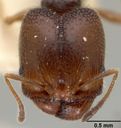Pheidole pilifera
Classification
- Phylum: Arthropoda
- Subphylum: Hexapoda
- Class: Insecta
- Order: Hymenoptera
- Superfamily: Formicoidea
- Family: Formicidae
- Subfamily: Myrmicinae
- Tribe: Attini
- Genus: Pheidole
- Species: pilifera
Pronunciation
How to pronounce Pheidole pilifera: /faɪˈdoʊli ˌpaɪlɪˈfɪərə/
These audio files are automatically generated. While they are not always 100% accurate, they are a good starting point.
Images






Summary
Pheidole pilifera is a highly adaptable species of ant known for its polymorphism and ecological significance. With multiple subspecies, it demonstrates a wide distribution and variety in physical characteristics.
Physical Characteristics
Pheidole pilifera exhibits a typical myrmicine body structure with significant polymorphism, characterized by the presence of both major and minor worker castes. The major workers possess large heads with noticeable mandibles, while the minor workers have smaller, more slender structures.
Identification Tips
Look for the distinct size difference between major and minor workers; majors have large heads and robust bodies, while minors are more slender. Antennal segmentation and the presence of spines on the thorax can aid identification.
Habitat
Pheidole pilifera typically inhabits a variety of terrestrial ecosystems, often found in forested areas or open landscapes with suitable nesting sites.
Distribution
This species can be found across a broad range of habitats in North America, particularly in regions with temperate climates.
Diet
Pheidole pilifera primarily feeds on a mix of protein, sugar, and fats, often scavenging for insects and harvesting honeydew from aphids.
Life Cycle
The life cycle of Pheidole pilifera follows a typical ant developmental process, including stages as egg, larva, pupa, and adult. The duration of each stage varies based on environmental conditions.
Reproduction
Mating occurs in flight during nuptial flights, after which the queen establishes a new colony. The colony grows from a small number of initial workers to a larger social structure.
Predators
Predators of Pheidole pilifera may include various insectivorous birds, reptiles, and other insect species.
Ecosystem Role
As a forager and scavenger, Pheidole pilifera plays a key role in nutrient cycling and soil aeration. They also participate in the regulation of herbivore populations and seed dispersal.
Collecting Methods
- Pitfall traps
- Hand collecting
- Baiting traps
Preservation Methods
- Ethanol
- Pinning
- Drying
Similar Taxa
Tags
- Pheidole
- ants
- Formicidae
- myrmecology